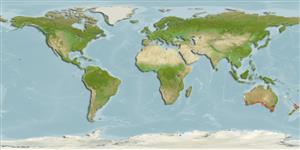Preferred temperature (Fonte Biblio.
123201): 14.7 - 20.5, mean 17.2 °C (based on 130 cells).
Phylogenetic diversity index (Fonte Biblio.
82804): PD
50 = 0.7500 [Uniqueness, from 0.5 = low to 2.0 = high].
Bayesian length-weight: a=0.00447 (0.00175 - 0.01142), b=2.99 (2.77 - 3.21), in cm total length, based on LWR estimates for this (Sub)family-body shape (Ref.
93245).
Trophic level (Fonte Biblio.
69278): 3.5 ±0.50 se; based on food items.
Generation time: 1.6 ( na - na) years. Estimated as median ln(3)/K based on 2
growth studies.
Resilienza (Fonte Biblio.
120179): Alto, tempo minimo di raddoppiamento della popolazione meno di 15 mesi (Preliminary K or Fecundity.).
Fishing Vulnerability (Ref.
59153): Low vulnerability (24 of 100).
🛈
Nutrients (Ref.
124155): Calcium = 23.8 [10.3, 47.2] mg/100g; Iron = 0.276 [0.138, 0.534] mg/100g; Protein = 18.6 [17.3, 19.9] %; Omega3 = 0.279 [0.138, 0.555] g/100g; Selenium = 11.8 [5.0, 30.4] μg/100g; VitaminA = 21.9 [4.6, 100.1] μg/100g; Zinc = 0.579 [0.361, 0.973] mg/100g (wet weight);
